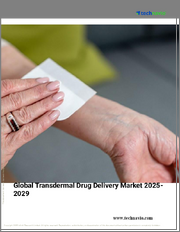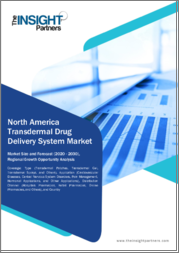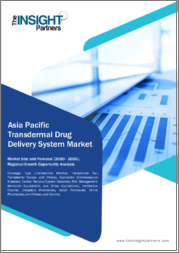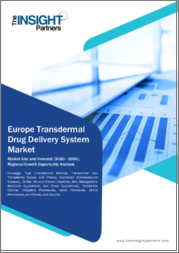
|
시장보고서
상품코드
1446443
세계 경피 약물전달 시스템 시장 - 규모, 점유율, 동향 분석 보고서 : 기술별, 용도별, 지역별 부문 예측(2024-2030년)Transdermal Drug Delivery Systems Market Size, Share & Trends Analysis Report By Technology (Iontophoresis, Mechanical Arrays), By Application, By Region, And Segment Forecasts, 2024 - 2030 |
||||||
경피 약물 전달 시스템 시장의 성장과 동향 :
Grand View Research, Inc.의 최신 보고서에 따르면 경피 약물 전달 시스템 세계 시장 규모는 CAGR 11.9%로 확대되어 2030년까지 1,450억 4,000만 달러에 달할 것으로 예측되고 있습니다.
경피 패치의 수용 확대, 특히 일관된 매일 인슐린 투여가 필요한 당뇨병과 같은 증상에 대한 수용 확대는 경피 약물 전달 시스템 분야 시장 성장을 가속할 것으로 예상됩니다.
또한, 당뇨병 환자는 정기적인 인슐린 투여를 필요로 하지만, 기존에는 주사에 의해 행해졌기 때문에 불쾌감이 생기거나 질병 감염의 위험이 높아질 수 있습니다. 이러한 이유로 경피 약물 전달 시스템은 인슐린을 전달하는 더 매력적인 선택이 될 것입니다. 시장 성장에 기여하는 또 다른 중요한 요인은 고통스럽지 않은 약물 전달에 대한 수요 증가입니다. 인슐린 투여를 위해 항상 주사를 사용하면 불쾌감과 만성 질환으로 이어질 수 있습니다. 경피 패치는 보다 편안하고 효율적인 인슐린 전달 방법을 제공하기 때문에 이러한 문제를 해결합니다.
또한, 당뇨병, 심장병, 통증 관련 문제 등의 만성 질환이 세계적으로 보편화됨에 따라, 효과적이고 환자에게 사용하기 쉬운 약물 전달 방법에 대한 필요성이 증가하고 있습니다. 예를 들어 미국 심장협회의 2022년판 세계질병부담보고서에 따르면 인구 10만명당 사망률은 239.8, 유병률은 7354.1이었습니다. 경피 약물 전달 시스템은 비침습성, 약물 방출 제어, 환자 충격 향상, 부작용 최소화 등 여러 가지 이점을 제공합니다. 이러한 사용자 친화적 인 약물 전달 시스템, 특히 장기 투여의 지속적인 관리에 대한 수요가 증가함에 따라 경피 약물 전달 시장의 성장이 촉진되고 있습니다.
경피 약물 전달 시스템 시장 보고서 하이라이트 :
- 2023년에는 이온토포레시스 분야가 가장 큰 시장 점유율을 차지했습니다. 이것은 전류를 이용하여 피부로부터 비침습적으로 약물을 전달하는 효과에 기인한다고 생각됩니다.
- 2023년에는 관절염, 골관절염, 정형외과적 퇴행성 질환 등 근골격계 장애를 포함한 만성 질환 및 외상 유병률이 증가하여 통증 관리 분야가 용도별 부문을 선도했습니다. 이러한 질병의 유병률 증가가 기여하고, 이 분야의 성장을 견인하고 있습니다.
- 호르몬 부문은 2023년 적용 부문에서 예측 기간 동안 지수 함수 CAGR로 성장할 것으로 예상됩니다. 이것은 간편한 호르몬 요법에 대한 수요 증가로 인한 것입니다. 경피 투여의 효능과 사용의 용이성은 호르몬 투여의 매력적인 해결책이 되었습니다.
- 북미는 고급 건강 관리 인프라와 만성 통증, 중추 신경계 장애 및 심혈관 질환과 같은 대상 질환의 높은 유병률로 2023년 최대 시장 점유율을 차지했습니다.
- 시장 기업은 제품 도달 범위를 확대하고 다양한 지역에서 가용성을 향상시키기 위해 몇 가지 전략적 이니셔티브를 채택하고 있습니다.
목차
제1장 경피 약물전달 시스템 시장 : 조사 방법과 범위
제2장 경피 약물전달 시스템 시장 : 주요 요약
- 시장 전망
- 부문 전망
- 경쟁 인사이트
제3장 경피 약물전달 시스템 시장 : 변수, 동향, 범위
- 시장 계통 전망
- 시장 역학
- 경피 드래그 약물전달 시스템 시장 분석 도구
제4장 경피 약물전달 시스템 시장 : 기술 추정 및 동향 분석
- 정의와 범위
- 기술 시장 점유율, 2023년과 2030년
- 부문 대시보드
- 기술 전망별 세계의 경피 약물전달 시스템 시장
- 시장용도와 예측 및 동향 분석, 2018-2030년까지
제5장 경피 약물전달 시스템 시장 : 용도의 추정 및 동향 분석
- 정의와 범위
- 용도 시장 점유율, 2023년과 2030년
- 부문 대시보드
- 용도별 세계의 경피 약물 전달 시스템 시장 전망
- 시장용도와 예측 및 동향 분석, 2018-2030년까지
제6장 경피 약물전달 시스템 시장 : 지역 추정 및 동향 분석
- 지역 시장 점유율 분석, 2023년 및 2030년
- 지역 시장 대시보드
- 세계 지역 시장 현황
- 시장 규모와 예측 트렌드 분석, 2018-2030년:
- 북미
- 미국
- 캐나다
- 유럽
- 영국
- 독일
- 프랑스
- 이탈리아
- 스페인
- 노르웨이
- 스웨덴
- 덴마크
- 아시아태평양
- 일본
- 중국
- 인도
- 호주
- 한국
- 태국
- 라틴아메리카
- 브라질
- 멕시코
- 아르헨티나
- 중동 및 아프리카
- 남아프리카
- 사우디아라비아
- 아랍에미리트(UAE)
- 쿠웨이트
제7장 경쟁 구도
- 주요 시장 진출기업에 의한 최근의 동향과 영향 분석
- 회사/경쟁의 분류
- 이노베이터
- 벤더 상황
- List of key distributors and channel partners
- Key customers
- Key company market share analysis, 2023
- Novartis AG
- Johnson & Johnson
- Mylan Pharmaceuticals, Inc.
- Boehringer Ingelheim GmbH
- AbbVie
- Grunenthal
- Skyepharma
- 3M Company
- Noven Pharmaceuticals, Inc.
- 4P Therapeutics, LLC
- Hisamitsu Pharmaceutical co. Inc
Transdermal Drug Delivery Systems Market Growth & Trends:
The global transdermal drug delivery systems market size is anticipated to reach to reach USD 145.04 billion by 2030, expanding at a CAGR of 11.9%, based on a new report by Grand View Research, Inc. The growing acceptance of transdermal patches, particularly for conditions like diabetes that necessitate consistent and daily insulin dosage, is projected to drive market growth in the transdermal drug delivery systems sector.
In addition, diabetes patients require regular insulin administration, traditionally done through injections, which can cause discomfort and increase the risk of disease transmission. This makes transdermal drug delivery system will be a more appealing alternative for delivering insulin.Another significant factor contributing to the growth of the market is the rising demand for painless drug delivery. The constant use of injections for insulin administration can lead to discomfort and even chronic diseases. Transdermal patches offer a more comfortable and efficient way of delivering insulin, thus addressing these issues.
Moreover, chronic diseases like diabetes, heart conditions, and pain-related issues become more common globally, there is a greater need for drug delivery methods that are both effective and easy for patients to use. For example, according to the American Heart Association's 2022 report on the Global Burden of Disease, the death rate per 100,000 people was 239.8, while the prevalence rate was 7354.1 per 100,000. Transdermal drug delivery systems come with multiple benefits such as being non-invasive, providing controlled drug release, enhancing patient adherence, and minimizing side effects. This increasing demand for user-friendly drug delivery systems, particularly for the ongoing management of long-term medications, is driving the transdermal drug delivery market growth.
Transdermal Drug Delivery Systems Market Report Highlights:
- In 2023, the iontophoresis segment accounted for the largest market share. This can be attributed due to its effectiveness in delivering medications non-invasively through the skin using electrical currents
- In 2023, the pain management segment led the application segment due to the increasing prevalence of chronic diseases and trauma, including musculoskeletal disorders such as arthritis, osteoarthritis, and orthopedic degenerative disorders. The growing prevalence of these conditions is contributing, driving the segment growth
- The hormone segment is expected to grow at an exponential CAGR during the forecast period in the application segment in 2023. This is due to rising demand for convenient hormone therapies. Transdermal delivery's effectiveness and user-friendliness make it an attractive solution for administering hormones
- The North American region held the largest market share in 2023 due to advanced healthcare infrastructure and high prevalence of targeted diseases like chronic pain, central nervous system disorders, and cardiovascular diseases in the region
- Market players adopt several strategic initiatives to increase the product reach and improve availability in diverse geographic areas
Table of Contents
Chapter 1. Transdermal Drug Delivery Systems Market: Methodology and Scope
- 1.1. Market Segmentation & Scope
- 1.1.1. Technology
- 1.1.2. Application
- 1.1.3. Regional scope
- 1.1.4. Estimates and forecast timeline
- 1.2. Research Methodology
- 1.3. Information Procurement
- 1.3.1. Purchased database.
- 1.3.2. GVR's internal database
- 1.3.3. Secondary sources
- 1.3.4. Primary research
- 1.3.5. Details of primary research
- 1.3.5.1. Data for primary interviews in North America
- 1.3.5.2. Data for primary interviews in Europe
- 1.3.5.3. Data for primary interviews in Asia Pacific
- 1.3.5.4. Data for primary interviews in Latin America
- 1.3.5.5. Data for Primary interviews in MEA
- 1.4. Information or Data Analysis
- 1.4.1. Data analysis models
- 1.5. Market Formulation & Validation
- 1.6. Model Details
- 1.6.1. Commodity flow analysis (Model 1)
- 1.6.1.1. Approach 1: Commodity flow approach
- 1.6.2. Volume price analysis (Model 2)
- 1.6.2.1. Approach 2: Volume price analysis
- 1.6.1. Commodity flow analysis (Model 1)
- 1.7. List of Secondary Sources
- 1.8. List of Primary Sources
- 1.9. Objectives
Chapter 2. Transdermal Drug Delivery Systems Market: Executive Summary
- 2.1. Market Outlook
- 2.2. Segment Outlook
- 2.2.1. Technology outlook
- 2.2.2. Application outlook
- 2.2.3. Regional outlook
- 2.3. Competitive Insights
Chapter 3. Transdermal Drug Delivery Systems Market: Variables, Trends & Scope
- 3.1. Market Lineage Outlook
- 3.1.1. Parent market outlook
- 3.1.2. Related/ancillary market outlook.
- 3.2. Market Dynamics
- 3.2.1. Market driver analysis
- 3.2.1.1. Increasing adoption of transdermal patches
- 3.2.1.2. Technological advancements
- 3.2.1.3. High demand for pain free drug delivery
- 3.2.2. Market restraint analysis
- 3.2.2.1. High cost of transdermal technology
- 3.2.2.2. Limited number of approved medications
- 3.2.1. Market driver analysis
- 3.3. Transdermal Drug Delivery System Market Analysis Tools
- 3.3.1. Industry Analysis - Porter's
- 3.3.1.1. Supplier power
- 3.3.1.2. Buyer power
- 3.3.1.3. Substitution threat
- 3.3.1.4. Threat of new entrant
- 3.3.1.5. Competitive rivalry
- 3.3.2. PESTEL Analysis
- 3.3.2.1. Political landscape
- 3.3.2.2. Technological landscape
- 3.3.2.3. Economic landscape
- 3.3.1. Industry Analysis - Porter's
Chapter 4. Transdermal Drug Delivery Systems Market: Technology Estimates & Trend Analysis
- 4.1. Definitions and Scope
- 4.1.1. Electroporation
- 4.1.2. Radio Frequency
- 4.1.3. Iontophoresis
- 4.1.4. Microporation
- 4.1.5. Thermal
- 4.1.6. Mechanical arrays
- 4.1.7. Ultrasound
- 4.1.8. Others
- 4.2. Technology Market Share, 2023 & 2030
- 4.3. Segment Dashboard
- 4.4. Global Transdermal Drug Delivery System Market by Technology Outlook
- 4.5. Market Application & Forecasts and Trend Analyses, 2018 to 2030 for the following
- 4.5.1. Electroporation
- 4.5.1.1. Market estimates and forecast 2018 - 2030 (Revenue in USD Million)
- 4.5.2. Radio Frequency
- 4.5.2.1. Market estimates and forecast, 2018 - 2030 (Revenue in USD Million)
- 4.5.3. Iontophoresis
- 4.5.3.1. Market estimates and forecast, 2018 - 2030 (Revenue in USD Million)
- 4.5.4. Microporation
- 4.5.4.1. Market estimates and forecast, 2018 - 2030 (Revenue in USD Million)
- 4.5.5. Thermal
- 4.5.5.1. Market estimates and forecast, 2018 - 2030 (Revenue in USD Million)
- 4.5.6. Mechanical Arrays
- 4.5.6.1. Market estimates and forecast, 2018 - 2030 (Revenue in USD Million)
- 4.5.7. Ultrasound
- 4.5.7.1. Market estimates and forecast, 2018 - 2030 (Revenue in USD Million)
- 4.5.8. Others
- 4.5.8.1. Market estimates and forecast, 2018 - 2030 (Revenue in USD Million)
- 4.5.1. Electroporation
Chapter 5. Transdermal Drug Delivery System Market: Application Estimates & Trend Analysis
- 5.1. Definitions and Scope
- 5.1.1. CNS
- 5.1.2. Pain Management
- 5.1.3. Cardiovascular
- 5.1.4. Hormone
- 5.1.5. Immunological
- 5.1.6. Metabolic
- 5.1.7. Gastrointestinal
- 5.1.8. Infection
- 5.1.9. Cancer
- 5.1.10. Others
- 5.2. Application Market Share, 2023 & 2030
- 5.3. Segment Dashboard
- 5.4. Global Transdermal Drug Delivery System Market by Application Outlook
- 5.5. Market Application & Forecasts and Trend Analyses, 2018 to 2030 for the following
- 5.5.1. CNS
- 5.5.1.1. Market estimates and forecast, 2018 - 2030 (Revenue in USD Million)
- 5.5.2. Pain Management
- 5.5.2.1. Market estimates and forecast, 2018 - 2030 (Revenue in USD Million)
- 5.5.3. Cardiovascular
- 5.5.3.1. Market estimates and forecast, 2018 - 2030 (Revenue in USD Million)
- 5.5.4. Hormone
- 5.5.4.1. Market estimates and forecast, 2018 - 2030 (Revenue in USD Million)
- 5.5.5. Immunological
- 5.5.5.1. Market estimates and forecast, 2018 - 2030 (Revenue in USD Million)
- 5.5.6. Metabolic
- 5.5.6.1. Market estimates and forecast, 2018 - 2030 (Revenue in USD Million)
- 5.5.7. Gastrointestinal
- 5.5.7.1. Market estimates and forecast, 2018 - 2030 (Revenue in USD Million)
- 5.5.8. Infection
- 5.5.8.1. Market estimates and forecast, 2018 - 2030 (Revenue in USD Million)
- 5.5.9. Cancer
- 5.5.9.1. Market estimates and forecast, 2018 - 2030 (Revenue in USD Million)
- 5.5.10. Others
- 5.5.10.1. Market estimates and forecast, 2018 - 2030 (Revenue in USD Million)
- 5.5.1. CNS
Chapter 6. Transdermal Drug Delivery System Market: Regional Estimates & Trend Analysis
- 6.1. Regional Market Share Analysis, 2023 & 2030
- 6.2. Regional Market Dashboard
- 6.3. Global Regional Market Snapshot
- 6.4. Market Size, & Forecasts Trend Analysis, 2018 to 2030:
- 6.5. North America
- 6.5.1. U.S.
- 6.5.1.1. Key country dynamics
- 6.5.1.2. Competitive scenario
- 6.5.1.3. Regulatory framework
- 6.5.1.4. Reimbursement scenario
- 6.5.1.5. U.S. market estimates and forecast, 2018 - 2030 (USD Million)
- 6.5.2. Canada
- 6.5.2.1. Key country dynamics
- 6.5.2.2. Competitive scenario
- 6.5.2.3. Regulatory framework
- 6.5.2.4. Reimbursement scenario
- 6.5.2.5. Canada market estimates and forecast, 2018 - 2030 (USD Million)
- 6.5.1. U.S.
- 6.6. Europe
- 6.6.1. UK
- 6.6.1.1. Key country dynamics
- 6.6.1.2. Competitive scenario
- 6.6.1.3. Regulatory framework
- 6.6.1.4. Reimbursement scenario
- 6.6.1.5. UK market estimates and forecast, 2018 - 2030 (USD Million)
- 6.6.2. Germany
- 6.6.2.1. Key country dynamics
- 6.6.2.2. Competitive scenario
- 6.6.2.3. Regulatory framework
- 6.6.2.4. Reimbursement scenario
- 6.6.2.5. Germany market estimates and forecast, 2018 - 2030 (USD Million)
- 6.6.3. France
- 6.6.3.1. Key country dynamics
- 6.6.3.2. Competitive scenario
- 6.6.3.3. Regulatory framework
- 6.6.3.4. Reimbursement scenario
- 6.6.3.5. France market estimates and forecast, 2018 - 2030 (USD Million)
- 6.6.4. Italy
- 6.6.4.1. Key country dynamics
- 6.6.4.2. Competitive scenario
- 6.6.4.3. Regulatory framework
- 6.6.4.4. Reimbursement scenario
- 6.6.4.5. Italy market estimates and forecast, 2018 - 2030 (USD Million)
- 6.6.5. Spain
- 6.6.5.1. Key country dynamics
- 6.6.5.2. Competitive scenario
- 6.6.5.3. Regulatory framework
- 6.6.5.4. Reimbursement scenario
- 6.6.5.5. Spain market estimates and forecast, 2018 - 2030 (USD Million)
- 6.6.6. Norway
- 6.6.6.1. Key country dynamics
- 6.6.6.2. Competitive scenario
- 6.6.6.3. Regulatory framework
- 6.6.6.4. Reimbursement scenario
- 6.6.6.5. Norway market estimates and forecast, 2018 - 2030 (USD Million)
- 6.6.7. Sweden
- 6.6.7.1. Key country dynamics
- 6.6.7.2. Competitive scenario
- 6.6.7.3. Regulatory framework
- 6.6.7.4. Reimbursement scenario
- 6.6.7.5. Sweden market estimates and forecast, 2018 - 2030 (USD Million)
- 6.6.8. Denmark
- 6.6.8.1. Key country dynamics
- 6.6.8.2. Competitive scenario
- 6.6.8.3. Regulatory framework
- 6.6.8.4. Reimbursement scenario
- 6.6.8.5. Denmark market estimates and forecast, 2018 - 2030 (USD Million)
- 6.6.1. UK
- 6.7. Asia Pacific
- 6.7.1. Japan
- 6.7.1.1. Key country dynamics
- 6.7.1.2. Competitive scenario
- 6.7.1.3. Regulatory framework
- 6.7.1.4. Reimbursement scenario
- 6.7.1.5. Japan market estimates and forecast, 2018 - 2030 (USD Million)
- 6.7.2. China
- 6.7.2.1. Key country dynamics
- 6.7.2.2. Competitive scenario
- 6.7.2.3. Regulatory framework
- 6.7.2.4. Reimbursement scenario
- 6.7.2.5. China market estimates and forecast, 2018 - 2030 (USD Million)
- 6.7.3. India
- 6.7.3.1. Key country dynamics
- 6.7.3.2. Competitive scenario
- 6.7.3.3. Regulatory framework
- 6.7.3.4. Reimbursement scenario
- 6.7.3.5. India market estimates and forecast, 2018 - 2030 (USD Million)
- 6.7.4. Australia
- 6.7.4.1. Key country dynamics
- 6.7.4.2. Competitive scenario
- 6.7.4.3. Regulatory framework
- 6.7.4.4. Reimbursement scenario
- 6.7.4.5. Australia market estimates and forecast, 2018 - 2030 (USD Million)
- 6.7.5. South Korea
- 6.7.5.1. Key country dynamics
- 6.7.5.2. Competitive scenario
- 6.7.5.3. Regulatory framework
- 6.7.5.4. Reimbursement scenario
- 6.7.5.5. South Korea market estimates and forecast, 2018 - 2030 (USD Million)
- 6.7.6. Thailand
- 6.7.6.1. Key country dynamics
- 6.7.6.2. Competitive scenario
- 6.7.6.3. Regulatory framework
- 6.7.6.4. Reimbursement scenario
- 6.7.6.5. Thailand market estimates and forecast, 2018 - 2030 (USD Million)
- 6.7.1. Japan
- 6.8. Latin America
- 6.8.1. Brazil
- 6.8.1.1. Key country dynamics
- 6.8.1.2. Competitive scenario
- 6.8.1.3. Regulatory framework
- 6.8.1.4. Reimbursement scenario
- 6.8.1.5. Brazil market estimates and forecast, 2018 - 2030 (USD Million)
- 6.8.2. Mexico
- 6.8.2.1. Key country dynamics
- 6.8.2.2. Competitive scenario
- 6.8.2.3. Regulatory framework
- 6.8.2.4. Reimbursement scenario
- 6.8.2.5. Mexico market estimates and forecast, 2018 - 2030 (USD Million)
- 6.8.3. Argentina
- 6.8.3.1. Key country dynamics
- 6.8.3.2. Competitive scenario
- 6.8.3.3. Regulatory framework
- 6.8.3.4. Reimbursement scenario
- 6.8.3.5. Argentina market estimates and forecast, 2018 - 2030 (USD Million)
- 6.8.1. Brazil
- 6.9. MEA
- 6.9.1. South Africa
- 6.9.1.1. Key country dynamics
- 6.9.1.2. Competitive scenario
- 6.9.1.3. Regulatory framework
- 6.9.1.4. Reimbursement scenario
- 6.9.1.5. South Africa market estimates and forecast, 2018 - 2030 (USD Million)
- 6.9.2. Saudi Arabia
- 6.9.2.1. Key country dynamics
- 6.9.2.2. Competitive scenario
- 6.9.2.3. Regulatory framework
- 6.9.2.4. Reimbursement scenario
- 6.9.2.5. Saudi Arabia market estimates and forecast, 2018 - 2030 (USD Million)
- 6.9.3. UAE
- 6.9.3.1. Key country dynamics
- 6.9.3.2. Competitive scenario
- 6.9.3.3. Regulatory framework
- 6.9.3.4. Reimbursement scenario
- 6.9.3.5. UAE market estimates and forecast, 2018 - 2030 (USD Million)
- 6.9.4. Kuwait
- 6.9.4.1. Key country dynamics
- 6.9.4.2. Competitive scenario
- 6.9.4.3. Regulatory framework
- 6.9.4.4. Reimbursement scenario
- 6.9.4.5. Kuwait market estimates and forecast, 2018 - 2030 (USD Million)
- 6.9.1. South Africa
Chapter 7. Competitive Landscape
- 7.1. Recent Developments & Impact Analysis, By Key Market Participants
- 7.2. Company/Competition Categorization
- 7.2.1. Innovators
- 7.3. Vendor Landscape
- 7.3.1. List of key distributors and channel partners
- 7.3.2. Key customers
- 7.3.3. Key company market share analysis, 2023
- 7.3.4. Novartis AG
- 7.3.4.1. Company overview
- 7.3.4.2. Financial performance
- 7.3.4.3. Product benchmarking
- 7.3.4.4. Strategic initiatives
- 7.3.5. Johnson & Johnson
- 7.3.5.1. Company overview
- 7.3.5.2. Financial performance
- 7.3.5.3. Product benchmarking
- 7.3.5.4. Strategic initiatives
- 7.3.6. Mylan Pharmaceuticals, Inc.
- 7.3.6.1. Company overview
- 7.3.6.2. Financial performance
- 7.3.6.3. Product benchmarking
- 7.3.6.4. Strategic initiatives
- 7.3.7. Boehringer Ingelheim GmbH
- 7.3.7.1. Company overview
- 7.3.7.2. Financial performance
- 7.3.7.3. Product benchmarking
- 7.3.7.4. Strategic initiatives
- 7.3.8. AbbVie
- 7.3.8.1. Company overview
- 7.3.8.2. Financial performance
- 7.3.8.3. Product benchmarking
- 7.3.8.4. Strategic initiatives
- 7.3.9. Grunenthal
- 7.3.9.1. Company overview
- 7.3.9.2. Financial performance
- 7.3.9.3. Product benchmarking
- 7.3.9.4. Strategic initiatives
- 7.3.10. Skyepharma
- 7.3.10.1. Company overview
- 7.3.10.2. Financial performance
- 7.3.10.3. Product benchmarking
- 7.3.10.4. Strategic initiatives
- 7.3.11. 3M Company
- 7.3.11.1. Company overview
- 7.3.11.2. Financial performance
- 7.3.11.3. Product benchmarking
- 7.3.11.4. Strategic initiatives
- 7.3.12. Noven Pharmaceuticals, Inc.
- 7.3.12.1. Company overview
- 7.3.12.2. Financial performance
- 7.3.12.3. Product benchmarking
- 7.3.12.4. Strategic initiatives
- 7.3.13. 4P Therapeutics, LLC
- 7.3.13.1. Company overview
- 7.3.13.2. Financial performance
- 7.3.13.3. Product benchmarking
- 7.3.13.4. Strategic initiatives
- 7.3.14. Hisamitsu Pharmaceutical co. Inc
- 7.3.14.1. Company overview
- 7.3.14.2. Financial performance
- 7.3.14.3. Product benchmarking
- 7.3.14.4. Strategic initiatives
(주말 및 공휴일 제외)


















